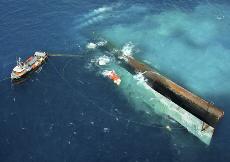Sunken ships may be used as flood barriers

With the help of air lift bags, air injection in ballast tanks and pull from two tugboats, the Spiegel Grove, a 510-foot retired Navy ship, begins to rotate in this June 10, 2002, file photo in the Florida Keys National Marine Sanctuary before it is prema The Associated Press
Jul 10, 2006
Last updated on May 12, 2016 at 03:36 a.m.
NEW ORLEANS – Marine scientists and Louisiana officials are floating the idea of sinking some of Uncle Sam’s cast-off ships along the water’s edge to create a steel barrier against hurricane flooding.
The barrier would be made up of aging and obsolete tankers, research vessels and cargo ships.
Since Hurricane Katrina hit, Louisiana is looking at every option for shoring up its storm defenses – especially quick fixes. Levees take years to build, and restoring lost marshes and cypress forests take even longer.
“When you’re in this desperate state, we can’t afford to laugh at anything,” said Paul Kemp with Louisiana State University’s School of the Coast and the Environment. Sinking ships could be done in a way that is safe for the environment, he said.
Get The Daily Illini in your inbox!
In recent days, state Sen. Walter Boasso has been talking up the idea on radio and at forums.
“What I don’t want to see happen is we have more studies and wait 20 years to have something done,” Boasso said. “I want to see something happen.”
Boasso represents St. Bernard Parish, 486 square miles of swamp, pasture and towns southeast of New Orleans. Nearly every square foot of the parish was inundated by Katrina, which broke levees.
The catastrophic flooding, St. Bernard officials say, was due in large part to a navigation channel that runs through the parish. Boasso said planting ships in the channel would go a long way to plugging what has been dubbed a “hurricane superhighway.”
The channel, called the Mississippi River-Gulf Outlet, was dug in the 1960s as a shortcut between New Orleans and the Gulf of Mexico, but it soon turned into an environmental horror story. The waterway tripled in width as tides and ship wakes eroded its banks. The gulf’s salt water encroached on cypress forest, swamp and marsh, killing an estimated 18,000 acres of marsh and 1,500 acres of cypress.
John Laguens, a St. Bernard community activist who has sought an end to the channel for years, said closing the channel is “just as important as building a levee system to protect St. Bernard.”
Shannon Russell, a spokeswoman for the U.S. Maritime Administration, said there are about 125 ships on the government disposal list. Most often, ships are bought by scrap metal companies. But recently, a retired Navy warship was sunk off the coast of Florida to create an artificial reef.
It can take years to get approval to sink a ship in open waters, Russell said. But Boasso’s proposal takes a different approach and seeks to use the ships as levees, something the U.S. Army Corps of Engineers would have authority over, she said.
Dan Hitchings, a top U.S. Army Corps of Engineers official in New Orleans, said the agency has not evaluated the idea.
Boasso said ships would be cheap to acquire, and the government might even give them to the state. He added that draining ships’ engines of oil and other contaminants to make them environmentally safe to sink could cost up to $300,000 each.
Some coastal advocates, though, think seeding the coast with ships is a poor substitute for more comprehensive restoration measures.
“Personally, I don’t want to settle for a bunch of hulking, rusty ships. I’d rather see a more natural solution,” said Kerry St. Pe’, executive director of Barataria Terrebonne National Estuary Program.
Louisiana is looking at many options for saving its coast and blocking the gulf. Some are conventional, such as the construction of floodgates and levees.
Others are more obscure. For example, some scientists want to barge mud from the Midwest and dump it on southern Louisiana’s sinking land.





